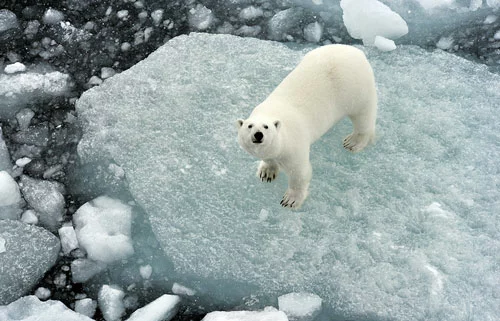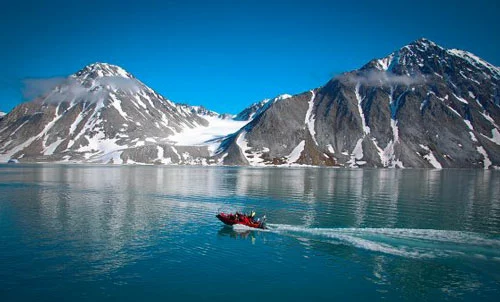
While Arctic tours are not cheap – the cost of a two-week cruise on the river Lena from Yakutsk to Tiksi up to 140 thousand rubles.
Regions of the Russian Arctic zone every year attract more and more tourists who go to see the northern lights, ride dog sleds and live in the plague, swim in hot springs in a 40-degree frost. As the head of Rosturizm Oleg Safonov told TASS, the Arctic zone has colossal prospects for the development of the tourism sector.
“We are actively developing tourism in the North-West, and it’s already possible to cruise to Franz Josef Land, about 1.5 thousand tourists arrive there annually, but we see a potential much higher – about 80 thousand people and we are working to increase the tourist flow, “he said.
Where tourists are going
Yakutia is interested in tourists with the national color of the local population, with northern culture. “In July, travelers can see the polar day, and August will please the white polar nights.In late August and early September, you can observe the riot of the Northern Lights, usually monochrome, the color happens much less often,” – said TASS general director of the Yakutia tourist company Lenaturflot- Daria Buzikova.
Murmansk region, possessing the only ice-free port of the Arctic zone of the Russian Federation, capable of taking ships year-round, attracts tourists with cruises to the top of the planet, as well as opportunities for active recreation, short and many-day snowmobile tours. “Zhemchuzhina” of the region is the reserve “Seydyavvri”, which is famous for unique landscapes, historical and cultural heritage of the Sami people.
“In the Arctic, they offer trips to the Khibiny and Lovozero mountains, from the White Sea to the Barents Sea, on the Rybachiy peninsulas and the Middle one, but the tours” Northern Lights Hunters “are very popular, tourists from Southeast Asia are ready to fly to the region for hundreds of thousands of kilometers, to admire this natural phenomenon, “the press service of the government of the Murmansk region noted. In the Yamal-Nenets Autonomous District (YaNAO), tourists go to get acquainted with the life of reindeer herders.
The Russian Arctic National Park is the northernmost and largest in Russia specially protected natural area of 8.8 million hectares, attracts expeditionists. The most popular places for tourists in the north of the Krasnoyarsk Territory are the Putorana Plateau, Lake Lama, the Permafrost Museum and the Mammoth Museum on the Taimyr Peninsula.
Polar monocity Vorkuta in Komi five years ago attracted more tourists to the memorable places of the Gulag, now visitors are more important northern hunting, fishing, untouched nature. Nenets Autonomous Okrug (NAO) also attracts cultural-cognitive, adventure tourism, hunting and fishing. In the Arctic zone of Karelia, the Paanajarvi National Park in Louhi district is popular.
The flow of tourists is growing every year: in the Murmansk region, an increase of 8% in 2016 (more than 330 thousand people), while the share of foreigners in the last two years increased by 39% to 38.9 thousand people due to travelers from Asia, in Yakutia this year the tourist flow is expected to grow by 13% to more than 202 thousand people, at the beginning of August 88,000 tourists visited YaNAO, last year more than 120 thousand people visited it. The National Park “Russian Arctic” received 1142 tourists from 36 countries this year, the number of travelers from Switzerland, France and Russia increased.
What to do in the Arctic
Sled dog tours to the Arctic coast of Yakutia, based on their experience of traveling in the Arctic, the general director of the company “Arctic Travel” Herman Arbugaev. He tested the tours, breaking the 1,500 km route to the Novosibirsk Islands through the ice-covered sea of the Laptev pathways of the first researchers of the Russian North of the 17th and 19th centuries.
“These tours are aimed at a rather narrow segment of tourists with high incomes and high standards of behavior skills in extremely cold temperatures, not everyone is ready to send himself to the Arctic for his own money. Nevertheless, there is a tendency to increase demand for the Arctic direction in In turn, we are ready to meet individual tourists, for this we have experience, equipment and a team, “Arbugaev said.
On the basis of the ethnographic complex “Chochur Muran” near Yakutsk, a week-long tour of “Sled dog safaris” is offered, where tourists pass the pre-school cue, learn to manage and communicate with dogs.
On a visit to reindeer herders and Arctic fishing
In the spring, Yamaltur signed a cooperation agreement with one of Australia’s largest tour operators Intrepid travel. “In August, 28 foreign tourists from Australia, the United States and Germany went on expeditions to Yamal -” Following the Reindeer Herders “and” The Far East Point of Europe. “Tourists got acquainted with the ethnographic heritage of the region, the way of life and traditions of indigenous minorities of the North, the life of the ancient Nerkagi, visited the camp of reindeer herders, took a ride on reindeer sleds, tried to establish a plague, caught reindeer, visited Salekhard.As a result of the trip, the Australian tour operator decided to continue cooperation, in the trail The region is expected by two international groups, “TASS was told in the press service of the Governor of Yamal-Nenets Autonomous District.
Extreme tours in the Yamal-Nenets Autonomous Region are also popular with tourists from Switzerland, Great Britain, France, Finland, Denmark, Ireland, Italy, and Belarus. Who has ever fished in the north, he will not want to fish any more, believes Kirill Arabov, head of the department of physical culture and sports of Vorkuta City Hall. “People are surprised, as in small streams, where the waters are knee-deep, you can catch a 2-kg grayling, and he fights for life on a par with a 4-pound pike, it’s very exciting.” On the river Kara you can catch a 5-kilogram fish of char, said the Arabov.

In the Nenets Museum-Reserve “Pustozersk” in September were opened two walking tours “Ancient roads of Pustozerye” with a length of 22 and 27 km. In summer they can be walked on foot, by bicycle or horse, in winter – by skiing or snowmobile, which is more interesting for local people, told TASS deputy director of the museum-reserve Elena Eliseeva.
New places for tourists were visited this year on Franz Josef Land, the archipelago in the Arctic Ocean, Alexander Kirilov, director of the Russian Arctic, said. “This year the guests first landed for a long time on the island of Algera near the Ziegler camp – the site of the American expeditions of Baldwin and Fiala at the beginning of the 20th century, as well as the island of Meybel and Cape Gemini on the island of Hayes. Polar Observatory named after E. Krenkel – TASS comment) on the island of Hayes for a visit after the completion of work to eliminate the accumulated environmental damage, “Kirilov said.
Rest for the elite
Despite the growing popularity, Arctic tourism is still a fairly expensive type of recreation, TASS’s interlocutors noted. The cost of a two-week Arctic cruise along the Lena River from Yakutsk to Tiksi is 140,000 rubles, depending on the type of accommodation. 90% of tours are bought by foreigners. Basically, these are organized groups of tourists from Germany, Sweden, Norway, Switzerland, New Zealand, said the head of the Yakutia travel company Buzikova.
“Arctic tourism is expensive – logistics expensive.” Vorkuta has developed 18 permanent tourist routes, but the price varies depending on the number of tourists, the equipment used, the time of the year .If it is spring, then only a helicopter with an hour of rent worth 300,000 rubles, ” – explained the representative of the City Hall of Vorkuta Arabov.
The cruise to the “top of the earth” from Murmansk to the North Pole on the nuclear-powered icebreaker “50 Years of Victory” costs an average of $ 27,000, the press service of the government of the Murmansk region said.
Queues to see the Karelian beauty
Another deterrent to the development of Arctic tourism is the lack of the necessary infrastructure: not only roads, but also hotels, equipped recreation areas. The Paanajarvi National Park in the north of Karelia annually receives about 7 thousand tourists from Europe and the regions of Russia. The park can not accept more because of the limited infrastructure.
“There are places for tent sites, several cabins for living, parking lots, but their number is limited, and in order to get into the park in the summer with an overnight stay, the application needs to be done in February.The increase in the flow is hampered primarily by the very poor condition of roads and financing the construction of infrastructure” , – the chief specialist of the park for public relations Natalia Bijon told TASS.
According to the head of the Union of Travel Industry of Karelia Olga Lukina, recently incorporated into the Arctic zone of the Russian Federation, the Louhi, Belomorsky, and Kemsky regions of Karelia still have infrastructure that is not developed for tourism development – there are not enough hotels and good roads. “For example, in the Louhi region, the attraction center for tourists is the Paanajarvi national park, but the road to it leaves much to be desired,” Lukin said.
Do not harm nature
The issue of preservation of the Arctic nature remains an urgent issue, the agency’s interlocutors acknowledge. “As soon as citizens have access to various types of equipment, so immediately in the Arctic began to appear traces of the presence of people, tourists are not yet fully conscious.” A separate headache is tractor roads that do not overgrow for a long time, “said Arabov.
The principle, as in medicine, “Do no harm” – the main criterion for the formation of hiking trails and places of stay in the tourist center of the Taimyr Peninsula “Reserves of Taimyr.” “The task of an employee of the reserves accompanying the group includes not only telling, acquaint tourists with the surrounding landscape, flora and fauna of the territory, but, if necessary, help people navigate in the wild, protect themselves from negative consequences, but most importantly – recall that we are only guests in the realm of nature, “the directorate of the Taimyr Nature Reserves emphasized.
In the National Park “Russian Arctic” developed local management plans, which describe in detail the visited points, rules of conduct and movement in the landings. “The movement of groups of tourists is organized in places of landing, which allows to avoid damage to plant communities, bird markets. Today they are created six: Tikhaya Bay, Roubini Rock, Apollonov Island, Bell Island, Champa Island, Cape Norway, Jackson Island,” Kirilov said.
The inspectors of the park on cruise ships are shifted 24 hours a day on the bridge and monitor compliance with environmental legislation. “When meeting with marine mammals, the vessel should be 150 meters from them and move to them not directly.” If the tourists wish, for example, to look at the bear, the ship must stop at a distance, and the predator can approach the ship himself if he wants. which should not be allowed to disturb the animals, feed, and even less pursue them or express violent emotions, “explained the park’s director.
Translation: Google
Source: TASS









